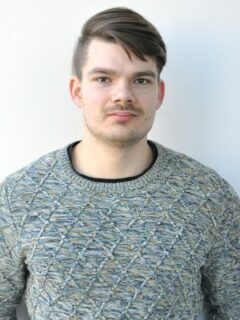Markus Lorke
Markus Lorke, M. Sc.
Doktorand
Development and characterization of hydrogels for engineered brain tissue like matrices
Supervisor: Prof. Dr.-Ing. habil. Dr. h.c. Aldo R. Boccaccini
Due to the presence of hyaluronic acid (HA) in native brain tissue, HA-based three-dimensional hydrogels are a promising approach to mimic neural tissue for the repair or regeneration of neurological defects and diseases [1]. Hereby, the right mechanical and biological properties, such as matrix stiffness and degradation kinetics, play a crucial role in mimicking the damaged tissue with the aim of achieving stimulatory effects and promoting cell proliferation [2]. These specific properties can be tailored by modifying the crosslinking density, the components of the hydrogel, or by oxidation degree of the polysaccharide [2,3]. In this project, hydrogels based on hyaluronic acid will be modified towards different mechanical responses, the effects on long-term stability and cellular response to create engineered brain like matrices. The project is part of the Collaborative Research Centre SFB 1540 “Exploring Brain Mechanics” (EBM) at the University of Erlangen-Nuremberg.
[1] P. Madhusudanan, G. Raju, and S. Shankarappa, “Hydrogel systems and their role in neural tissue engineering,” Journal of the Royal Society Interface, vol. 17, no. 162, 2020.
[2] A. H. Pandit, N. Mazumdar, and S. Ahmad, “Periodate oxidized hyaluronic acid-based hydrogel scaffolds for tissue engineering applications,” International Journal of Biological Macromolecules, vol. 137, pp. 853–869, 2019.
[3] J. Thiele, Y. Ma, S. M. C. Bruekers, S. Ma, and W. T. S. Huck, “25th anniversary article: Designer hydrogels for cell cultures: A materials selection guide,” Advanced Materials, vol. 26, no. 1. pp. 125–148, 2014. doi: 10.1002/adma.201302958

